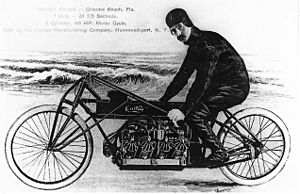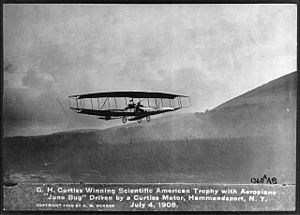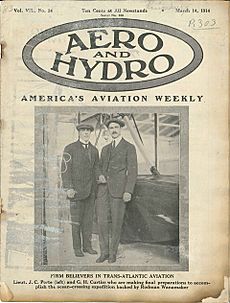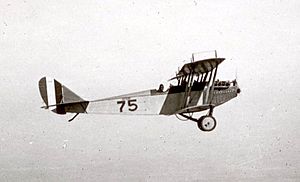Glenn Curtiss facts for kids
Quick facts for kids
Glenn Curtiss
|
|
|---|---|

Glenn Curtiss c. 1909
|
|
| Born |
Glenn Hammond Curtiss
May 21, 1878 |
| Died | July 23, 1930 (aged 52) |
| Occupation | Aviator Company director |
| Known for | Bicycle racing Motorcycle racing Air racing Naval aviation Flying boats Transatlantic flight Founder of the Curtiss Aeroplane and Motor Company |
| Spouse(s) | Lena Pearl Neff (March 7, 1898 – until his death) |
| Children | 2 |
Glenn Hammond Curtiss (born May 21, 1878 – died July 23, 1930) was an American expert in aviation and motorcycling. He was also a key person in starting the U.S. aircraft industry. Glenn began his career by racing and building bicycles. Then, he moved on to motorcycles.
By 1904, he started making engines for airships. In 1908, Curtiss joined the Aerial Experiment Association (AEA). This was a special group started by Alexander Graham Bell to build flying machines.
Curtiss won a big race at the world's first international air show in France. He also made the first long-distance flight in the U.S. His work in designing and building aircraft led to the creation of the Curtiss Aeroplane and Motor Company. This company later joined with another to become the Curtiss-Wright Corporation. His company built planes for the U.S. Army and Navy. Before World War I, his experiments with seaplanes helped make naval aviation better. Curtiss's planes were very important during the years between the World Wars and during World War II.
Early Life and First Jobs
Glenn Curtiss was born in Hammondsport, New York, in 1878. His father, Frank Richmond Curtiss, made horse harnesses. Glenn's family had moved to Hammondsport a few years before he was born.
Even though he only went to school until eighth grade, Glenn loved mechanics and inventing things. His first job was at the Eastman Dry Plate and Film Company, which later became Kodak. There, he invented a machine that helped make copies. He also built a simple camera to learn about photography.
Family Life
On March 7, 1898, Glenn Curtiss married Lena Pearl Neff in Hammondsport, New York. They had two children together: Carlton N. Curtiss and Glenn Hammond Curtiss.
Bicycles and Motorcycles
Glenn Curtiss started his career as a Western Union bicycle messenger. He also raced bicycles and owned a bicycle shop. In 1901, he became very interested in motorcycles. This was when engines that burned fuel inside became more common.
In 1902, Curtiss began building motorcycles with his own engines. His first motorcycle's carburetor was made from a tomato soup can! In 1903, he set a motorcycle land speed record. He rode at 64 miles per hour (103 km/h) for one mile.
On January 24, 1907, Curtiss set an unofficial world record. He rode his own Curtiss V-8 motorcycle at 136.36 miles per hour (219.45 km/h) in Ormond Beach, Florida. This motorcycle had a 40 horsepower (30 kW) V-8 engine. This engine was actually designed for airplanes. He was known as "the fastest man in the world" until 1911. His motorcycle speed record was not broken until 1930. This famous motorcycle is now in the Smithsonian Institution. Curtiss's racing success made him well-known for making powerful motorcycles and engines.
Becoming an Aviation Pioneer
Curtiss, the Engine Expert
In 1904, Curtiss started making engines for airships. One of his engines powered the California Arrow. This was the first successful dirigible in America.
In 1907, Alexander Graham Bell asked Curtiss to help. Bell wanted him to create a good engine for flying machines. Bell thought Curtiss was "the greatest motor expert in the country." He invited Curtiss to join his Aerial Experiment Association (AEA).
AEA Aircraft Experiments
Between 1908 and 1910, the AEA built four airplanes. Each new plane was better than the last. Curtiss mainly designed the third plane, called the June Bug. He also became its test pilot.
On July 4, 1908, he flew the June Bug 5,080 ft (1,550 m). He won the Scientific American Trophy and a $2,500 prize. This was the first public flight of a flying machine in America that was announced beforehand. The flight of the June Bug made Curtiss and aviation famous. On June 8, 1911, Curtiss received U.S. Pilot's License #1. He got this license because they were given out in alphabetical order.
The Years Before World War I
Aviation Competitions
After leaving the AEA in 1909, Curtiss started the Herring-Curtiss Company. He hired many pilots to show off his planes. These pilots flew in air competitions and demonstrations across North America. This helped introduce aviation to many curious people. Curtiss used these events to promote his aircraft.

In August 1909, Curtiss went to a big aviation meeting in France. On August 28, 1909, he flew his No. 2 biplane. He won the Gordon Bennett Cup for speed. He flew the 20-km (12.5-mile) course in less than 16 minutes. His speed was 46.5 mph (74.8 km/h).
On May 29, 1910, Curtiss flew from Albany to New York City. This was the first long-distance flight between two major U.S. cities. He flew 137-mile (220 km) in just under four hours. He stopped twice to refuel. For this flight, he won a $10,000 prize.
In 1910, Curtiss showed naval officers how planes could drop bombs. Later that year, he helped an officer show that planes could shoot at targets on the ground. In September, he trained Blanche Stuart Scott. She was possibly the first American woman pilot.
Patent Challenges
The Wright brothers had a patent lawsuit against Curtiss starting in 1909. This legal fight continued until World War I. The U.S. government needed combat aircraft badly. So, they pushed both companies to settle their disagreement. The Wright Brothers eventually won all their court cases against Curtiss and others in the United States.
On November 14, 1910, Curtiss's pilot, Eugene Ely, took off from a platform. This platform was on the ship USS Birmingham. His successful flight showed the start of a long relationship between Curtiss and the Navy. At the end of 1910, Curtiss set up a camp in San Diego. Here, he taught Army and Navy people how to fly. He trained Lt. Theodore Ellyson, who became U.S. Naval Aviator #1. The Navy now calls this place "The Birthplace of Naval Aviation."
That winter, Curtiss created a special float design. This allowed planes to take off and land on water. On January 26, 1911, he flew the first seaplane from water in the United States. These new planes interested the Navy a lot. Even more important, Eugene Ely landed his Curtiss plane on a platform on the battleship USS Pennsylvania. This was the first time a plane landed on a ship using a special cable system. It was a big step for modern aircraft carriers.
On February 24, 1911, Curtiss showed his first amphibious plane. This plane could take off and land on both land and water. Six months later, in July 1911, Curtiss sold the U.S. Navy their first plane. It was called the A-1 Triad. The A-1 was mainly a seaplane, but it also had wheels that could be pulled up. This made it the first amphibious aircraft. Curtiss trained the Navy's first pilots and built their first planes. Because of this, he is called "The Father of Naval Aviation" in the U.S. The Triad was so useful that the U.S. Navy, Russia, Japan, Germany, and Britain all bought it. Curtiss won the Collier Trophy for designing this aircraft.
Around this time, Curtiss met a British naval officer named John Cyril Porte. Porte wanted to build a plane to win a prize for the first transatlantic crossing. In 1912, Curtiss made the Flying Fish. This was a larger plane that was called a flying boat. It had a special "step" in its bottom that helped it lift off the water. Curtiss realized this design was good for building bigger, long-distance planes that could fly from water. With help from Rodman Wanamaker, Porte and Curtiss built the America in 1914. This was a larger flying boat with two engines, made for crossing the Atlantic.
World War I and Beyond
World War I
When World War I began, John Cyril Porte went back to serve in the Royal Navy. The Royal Navy bought several America models from Curtiss. These planes were called the H-4. Porte improved the designs and built long-range patrol planes in Britain. These British designs were later sold to the U.S. forces.
As 1916 approached, the United States worried about joining the war. The Army asked Curtiss to design a simple, easy-to-fly trainer plane. Curtiss created the JN-4 "Jenny" for the Army. He also made the N-9 seaplane version for the Navy. These were some of the most famous planes from Curtiss's company. Thousands were sold to the militaries of the United States, Canada, and Britain. The demand for planes grew, and the company hired 18,000 workers in Buffalo and 3,000 in Hammondsport.
In 1917, the U.S. Navy asked Curtiss to design a large, four-engine flying boat. It needed to hold a crew of five. This plane became known as the Curtiss NC. Three of the four NC flying boats tried to cross the Atlantic in 1919. The NC-4 became the first aircraft to fly across the Atlantic Ocean. The other two planes, NC-1 and NC-3, could not finish the trip. The NC-4 is now on display at the National Naval Aviation Museum in Pensacola, Florida.
After World War I
After World War I ended, many wartime contracts were canceled. In September 1920, the Curtiss Aeroplane and Motor Company changed its financial structure. Glenn Curtiss sold his shares in the company for $32 million and retired to Florida. He remained a director but only advised on design. The company later became a big part of a larger group of aviation companies.
Later Years

Curtiss and his family moved to Florida in the 1920s. There, he started 18 companies. He also served on city committees and gave away a lot of land and water rights. He helped develop the city of Hialeah. He also developed the cities of Opa-locka and Miami Springs. In Miami Springs, he built his family home, now known as the Glenn Curtiss Mansion. This house is being fixed up to become a museum in his honor.
His hunting trips in the Florida Everglades led to his last invention. This was the Adams Motor "Bungalo," an early version of today's recreational vehicle trailer. Curtiss later made a bigger, more detailed version called the Aerocar. He sold these vehicles. Shortly before he died, he designed a tailless airplane. He hoped it could be sold for the price of a family car.
The Wright Aeronautical Corporation joined with the Curtiss Aeroplane and Motor Company on July 5, 1929. They formed the Curtiss-Wright company. This happened shortly before Curtiss's death.
Death
Glenn Curtiss traveled to Rochester for a lawsuit. During the court case, he had an attack of appendicitis. He died on July 23, 1930, in Buffalo, New York. His death was due to problems from an appendectomy. His funeral was held in his hometown of Hammondsport. He was buried in the family plot at Pleasant Valley Cemetery.
Awards and Honors
On March 1, 1933, Congress gave Curtiss the Distinguished Flying Cross after he had passed away. This award is now at the Smithsonian Institution. Curtiss was added to the National Aviation Hall of Fame in 1964. He was also honored in the International Aerospace Hall of Fame in 1965. In 1990, he joined the Motorsports Hall of Fame of America. He was inducted into the Motorcycle Hall of Fame in 1998 and the National Inventors Hall of Fame in 2003.
The Smithsonian's National Air and Space Museum has many of Curtiss's original papers. They also have a collection of his airplanes, motorcycles, and engines. LaGuardia Airport was first called Glenn H. Curtiss Airport when it opened in 1929.
Many places are named after Curtiss. These include Curtiss Avenue in Hammondsport, NY, and Glenn Curtiss Elementary School. There's also Glenn Hammond Curtiss Middle School in Carson, CA. Curtiss appeared on the cover of Time magazine in 1924. He was also featured on a U.S. airmail stamp and a Micronesian stamp. Curtiss airplanes have appeared on 15 U.S. stamps and stamps from at least 17 other countries.
Images for kids
See also
 In Spanish: Glenn Curtiss para niños
In Spanish: Glenn Curtiss para niños








